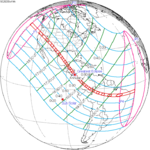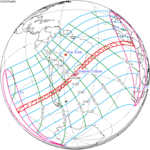Solar eclipse of April 20, 2023
| Solar eclipse of April 20, 2023 | |
|---|---|
 Partial from Magetan, Indonesia | |
| Type of eclipse | |
| Nature | Hybrid |
| Gamma | −0.3952 |
| Magnitude | 1.0132 |
| Maximum eclipse | |
| Duration | 76 s (1 min 16 s) |
| Coordinates | 9°36′S 125°48′E / 9.6°S 125.8°E |
| Max. width of band | 49 km (30 mi) |
| Times (UTC) | |
| Greatest eclipse | 4:17:56 |
| References | |
| Saros | 129 (52 of 80) |
| Catalog # (SE5000) | 9559 |
One of the rarest Solar eclipses, a hybrid solar eclipse will occur on Thursday, April 20, 2023. A solar eclipse occurs when the Moon passes between Earth and the Sun thereby totally or partly obscuring the image of the Sun for a viewer on Earth. A total solar eclipse occurs when the Moon's apparent diameter is larger than the Sun's, blocking all direct sunlight, turning day into darkness. A Hybrid solar eclipse is a rare type of solar eclipse that changes its appearance as the Moon's shadow moves across the earth's surface. Totality occurs in a narrow path across the surface of the Earth, with the partial solar eclipse visible over a surrounding region thousands of kilometres wide.
Totality for this eclipse will be visible in the North West Cape peninsula and Barrow Island in Western Australia, eastern parts of East Timor, as well as Damar Island and parts of the province of Papua in Indonesia.[1]
It is a hybrid eclipse, with portions of its path near sunrise and sunset as annular.
Images
Related eclipses
Tzolkinex
- Preceded: Solar eclipse of March 8-9, 2016
- Followed: Solar eclipse of June 1, 2030
Half-Saros cycle
- Preceded: Lunar eclipse of April 15, 2014
- Followed: Lunar eclipse of April 25, 2032
Tritos
- Preceded: Solar eclipse of May 20-21, 2012
- Followed: Solar eclipse of March 20, 2034
Solar Saros 129
- Preceded: Solar eclipse of April 8, 2005
- Followed: Solar eclipse of April 30, 2041
Inex
- Preceded: Solar eclipse of May 10, 1994
- Followed: Solar eclipse of March 30, 2052
Triad
- Preceded: Solar eclipse of June 19, 1936
- Followed: Solar eclipse of February 18-19, 2110
Eclipses of 2023
- A hybrid solar eclipse on April 20.
- A penumbral lunar eclipse on May 5.
- An annular solar eclipse on October 14.
- A partial lunar eclipse on October 28.
Solar eclipses of 2022–2025
This eclipse is a member of a semester series. An eclipse in a semester series of solar eclipses repeats approximately every 177 days and 4 hours (a semester) at alternating nodes of the Moon's orbit.[2]
| Solar eclipse series sets from 2022 to 2025 | ||||||
|---|---|---|---|---|---|---|
| Ascending node | Descending node | |||||
| Saros | Map | Gamma | Saros | Map | Gamma | |
119 Partial in CTIO, Chile |
April 30, 2022 Partial |
−1.19008 | 124 Partial from Saratov, Russia |
October 25, 2022 Partial |
1.07014 | |
129 Partial in Magetan, Indonesia |
April 20, 2023 Hybrid |
−0.39515 | 134 Annularity in Hobbs, NM, USA |
October 14, 2023 Annular |
0.37534 | |
139 Totality in Dallas, TX, USA |
April 8, 2024 Total |
0.34314 | 144 Annularity in Santa Cruz Province, Argentina |
October 2, 2024 Annular |
−0.35087 | |
| 149 | March 29, 2025 Partial |
1.04053 | 154 | September 21, 2025 Partial |
−1.06509 | |
Saros 129
This eclipse is a part of Saros series 129, repeating every 18 years, 11 days, and containing 80 events. The series started with a partial solar eclipse on October 3, 1103. It contains annular eclipses from May 6, 1464 through March 18, 1969; hybrid eclipses from March 29, 1987 through April 20, 2023; and total eclipses from April 30, 2041 through July 26, 2185. The series ends at member 80 as a partial eclipse on February 21, 2528. Its eclipses are tabulated in three columns; every third eclipse in the same column is one exeligmos apart, so they all cast shadows over approximately the same parts of the Earth.
The longest duration of annularity was produced by member 34 at 5 minutes, 10 seconds on October 4, 1698, and the longest duration of totality will be produced by member 58 at 3 minutes, 43 seconds on June 25, 2131. All eclipses in this series occur at the Moon’s ascending node of orbit.[3]
| Series members 40–61 occur between 1801 and 2200: | ||
|---|---|---|
| 40 | 41 | 42 |
 December 10, 1806 |
 December 20, 1824 |
 December 31, 1842 |
| 43 | 44 | 45 |
 January 11, 1861 |
 January 22, 1879 |
 February 1, 1897 |
| 46 | 47 | 48 |
 February 14, 1915 |
 February 24, 1933 |
 March 7, 1951 |
| 49 | 50 | 51 |
 March 18, 1969 |
 March 29, 1987 |
 April 8, 2005 |
| 52 | 53 | 54 |
 April 20, 2023 |
 April 30, 2041 |
 May 11, 2059 |
| 55 | 56 | 57 |
 May 22, 2077 |
 June 2, 2095 |
 June 13, 2113 |
| 58 | 59 | 60 |
 June 25, 2131 |
 July 5, 2149 |
 July 16, 2167 |
| 61 | ||
 July 26, 2185 | ||
Inex series
This eclipse is a part of the long period inex cycle, repeating at alternating nodes, every 358 synodic months (≈ 10,571.95 days, or 29 years minus 20 days). Their appearance and longitude are irregular due to a lack of synchronization with the anomalistic month (period of perigee). However, groupings of 3 inex cycles (≈ 87 years minus 2 months) comes close (≈ 1,151.02 anomalistic months), so eclipses are similar in these groupings.
| Inex series members between 1901 and 2100: | ||
|---|---|---|
 July 10, 1907 (Saros 125) |
 June 19, 1936 (Saros 126) |
 May 30, 1965 (Saros 127) |
 May 10, 1994 (Saros 128) |
 April 20, 2023 (Saros 129) |
 March 30, 2052 (Saros 130) |
 March 10, 2081 (Saros 131) |
||
Tritos series
This eclipse is a part of a tritos cycle, repeating at alternating nodes every 135 synodic months (≈ 3986.63 days, or 11 years minus 1 month). Their appearance and longitude are irregular due to a lack of synchronization with the anomalistic month (period of perigee), but groupings of 3 tritos cycles (≈ 33 years minus 3 months) come close (≈ 434.044 anomalistic months), so eclipses are similar in these groupings.
| Series members between 1901 and 2100 | |||
|---|---|---|---|
 March 29, 1903 (Saros 118) |
 February 25, 1914 (Saros 119) |
 January 24, 1925 (Saros 120) | |
 December 25, 1935 (Saros 121) |
 November 23, 1946 (Saros 122) |
 October 23, 1957 (Saros 123) | |
 September 22, 1968 (Saros 124) |
 August 22, 1979 (Saros 125) |
 July 22, 1990 (Saros 126) | |
 June 21, 2001 (Saros 127) |
 May 20, 2012 (Saros 128) |
 April 20, 2023 (Saros 129) | |
 March 20, 2034 (Saros 130) |
 February 16, 2045 (Saros 131) |
 January 16, 2056 (Saros 132) | |
 December 17, 2066 (Saros 133) |
 November 15, 2077 (Saros 134) |
 October 14, 2088 (Saros 135) | |
 September 14, 2099 (Saros 136) |
|||
Metonic series
The metonic series repeats eclipses every 19 years (6939.69 days), lasting about 5 cycles. Eclipses occur in nearly the same calendar date. In addition, the octon subseries repeats 1/5 of that or every 3.8 years (1387.94 days). All eclipses in this table occur at the Moon's ascending node.
| 21 eclipse events between July 1, 2000 and July 1, 2076 | ||||
|---|---|---|---|---|
| July 1–2 | April 19–20 | February 5–7 | November 24–25 | September 12–13 |
| 117 | 119 | 121 | 123 | 125 |
 July 1, 2000 |
 April 19, 2004 |
 February 7, 2008 |
 November 25, 2011 |
 September 13, 2015 |
| 127 | 129 | 131 | 133 | 135 |
 July 2, 2019 |
 April 20, 2023 |
 February 6, 2027 |
 November 25, 2030 |
 September 12, 2034 |
| 137 | 139 | 141 | 143 | 145 |
 July 2, 2038 |
 April 20, 2042 |
 February 5, 2046 |
 November 25, 2049 |
 September 12, 2053 |
| 147 | 149 | 151 | 153 | 155 |
 July 1, 2057 |
 April 20, 2061 |
 February 5, 2065 |
 November 24, 2068 |
 September 12, 2072 |
| 157 | ||||
 July 1, 2076 | ||||
References
- ^ Hybrid Solar Eclipse of 2023 Apr 20, National Aeronautics and Space Administration
- ^ van Gent, R.H. "Solar- and Lunar-Eclipse Predictions from Antiquity to the Present". A Catalogue of Eclipse Cycles. Utrecht University. Retrieved 6 October 2018.
- ^ "NASA - Catalog of Solar Eclipses of Saros 129". eclipse.gsfc.nasa.gov.
External links
- Earth visibility chart and eclipse statistics Eclipse Predictions by Fred Espenak, NASA/GSFC





